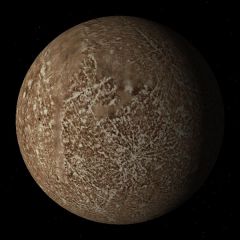Mercury
Mercury is the smallest planet in the solar system and is the closest to the sun. Mercury is a rocky planet appearing much like the moon and has virtually no atmosphere (none is modeled in Orbiter), and has no natural satellites.
Mercury was visited in 1974 and 1975 by Mariner 10 in two flybys and was again visited by MESSENGER spacecraft orbiting Mercury from 2011 to 2015 when it was deorbited. There is a plan for the BepiColombo spacecraft to visit in 2025.
Orbital characteristics
Mercury is the innermost planet in the system with a semimajor axis of 5.79×107 km. But, the orbital eccentricity is the largest of all the planets, about 0.2056, its distance ranging from 46 million to almost 70 million km from the Sun, and the inclination of its orbit is just over 7°, also largest of all the planets.
Physical characteristics
Mercury's mean radius is 2440 km, smaller than Ganymede and Titan, but more massive at a bit more than 3.3×1023 kg.[1] Mercury is unique in the solar system in that it is tidally locked with the Sun in a 3:2 spin-orbit resonance; it rotates three times for each two orbits around the Sun, which means that one day on Mercury is two of its years.[1] It also has the smallest axial tilt with respect to its orbit, about 2 arcminutes.
Geological features
In Orbiter 2016, Mercury is modeled as a sphere with no elevations, but visually, it has a texture and approximately 300 named features on Mercury have been included in the stock Orbiter 2016, albedo features as well as craters, ridges, plains, escarpments, valleys, and one mountain.
See Geology of Mercury for list of features.
Notice to pilots
CAUTION! It is to be noted by pilots flying close to the ground at Mercury when approaching the North and South poles. If the vessel crosses either pole at low altitude and any great speed, errors in the simulator causes the scenario to freeze and may cause Crash to Desktop. However, if the pole is approached at very low speed, perhaps one or a few meters per second, the vessel can pass over and even land at the pole.
Add-ons
- Mariner 10 - Historically the first probe to use gravitational assists and first probe to visit Mercury. It made three fly-by's of Mercury between November 1973 and March 1974, but did not enter orbit. Two add-ons are available at OrbitHangar - GEP-Mariner 10 by missleman01 and GEP - Mariner 10 to Orbiter 2010 by felipi1205. It is unknown if these are compatible with Orbiter 2016.
- MESSENGER - Historically the first probe to enter orbit around Mercury. After three fly-by's between January 2008 and September 2009, it entered an highly elliptical orbit around Mercury on March 18th, 2011. This probe is modeled in Orbiter in several add-ons Messenger by Ëåäíåff, GEP-Messenger by thexfiles19, and MESSENGER MOI by nukeet. It is unknown which versions these add-ons are compatible with.
- Mercury level 7 topography and level 8 textures at Orbit Hangar
- Mercury Level 8 texture at Orbit Hangar
- Mercury Level 9 Textures at Orbit Hangar The texture was created using mosaics of the planet Mercury with pictures taken by the MESSENGER spacecraft in 2011
- Mercury Level 11 texture at Orbit Hangar
External links
- Mercury at Wikipedia
- Mariner 10 mission at Wikipedia
- MESSENGER mission at Wikipedia
References
- ↑ Jump up to: 1.0 1.1 Orbiter.pdf (2016)
| edit The Solar System | |
|---|---|
| Central star |
Sun (Sol) |
| Planets |
Mercury - Venus - Earth - Mars - Jupiter - Saturn - Uranus - Neptune |
| Natural satellites |
Moon - Phobos - Deimos - Io - Europa - Ganymede - Titan - more... |
| Add-ons |
Planets - Dwarf Planets - Small objects - Natural satellites - Alternative star systems |
 | This article, about a planet, is a stub. You can help Orbiterwiki by expanding it. |
